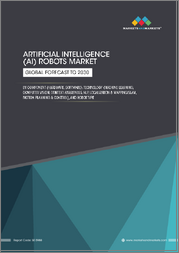
|
시장보고서
상품코드
1679326
로봇 기술 시장 예측(-2030년) : 유형별, 컴포넌트별, 기술별, 용도별, 지역별 세계 분석Robotics Technology Market Forecasts to 2030 - Global Analysis By Type (Industrial Robots, Service Robots, Collaborative Robots, Mobile Robots, Humanoid Robots, and Other Types), Component, Technology, Application and By Geography |
||||||
Stratistics MRC에 따르면 세계의 로봇 기술 시장은 2024년에 1,200억 5,000만 달러를 차지하며 2030년까지는 CAGR 17.2%로 성장하며, 3,111억 2,000만 달러에 달할 것으로 예측됩니다. 로봇 기술에는 일반적으로 인간이 수행하는 작업을 로봇이 수행할 수 있도록 설계, 개발, 적용하는 것을 포함합니다. 기계공학, 전기공학, 컴퓨터 과학, 인공지능 등 다양한 분야를 포괄하여 자동화 작업을 정확하고 효율적이며 신속하게 수행할 수 있는 기계를 만들어 냅니다. 로봇 기술은 생산성 향상, 인건비 절감, 안전성 향상, 복잡하고 위험한 환경에서의 혁신적인 솔루션 실현을 목표로 제조, 헬스케어, 물류, 국방 등 산업 전반에 적용되고 있습니다.
국제로봇연맹이 발표한 월드 로보틱스 보고서에 따르면 2021년에는 산업용 로봇 가동 대수가 378만 8,000대에 달할 것으로 예상되며, RIA 데이터에 따르면 2018년 미국, 멕시코와 함께 캐나다에 출하된 로봇은 35,880대로 전년 대비 7% 증가했습니다. 전년 대비 7% 증가했습니다.
협동 작업 로봇(코봇) 도입 증가
코봇은 안전하고 적응력이 뛰어나며 간단한 프로그래밍 기능을 갖추고 있으며, 모든 규모의 기업에 적합합니다. 또한 AI와 머신러닝의 발전으로 코봇의 능력이 향상되어 복잡한 작업을 수행할 수 있게 되었습니다. 코봇의 도입은 제조, 배송, 헬스케어 분야에서의 자동화의 필요성에 의해 촉진되고 있습니다. 산업계가 인건비 절감과 업무 효율성 향상을 원하는 가운데 코봇의 보급은 점점 더 가속화되고 있습니다.
숙련공 부족
로봇 기술의 급속한 발전에는 전문 지식과 전문 지식이 필요하지만, 이는 부족합니다. 많은 산업에서 로봇 시스템을 운영, 유지보수, 프로그래밍할 수 있는 유능한 인재를 확보하고 유지하는 데 어려움을 겪고 있습니다. 또한 기술 격차는 운영 비용 증가와 로봇 솔루션의 도입 지연으로 이어집니다. 이러한 문제를 해결하고 로봇 분야의 성장에 필요한 기술을 갖춘 인력을 양성하기 위해서는 교육 및 훈련 구상에 대한 투자가 필요합니다. 숙련된 인력의 부족은 여전히 로봇 기술 보급에 심각한 장벽으로 작용하고 있습니다.
성장하는 E-Commerce 및 물류 부문
온라인 쇼핑과 빠른 배송 서비스에 대한 수요가 증가함에 따라 창고 및 물류 센터의 자동화에 대한 필요성이 증가하고 있습니다. 자동운반차(AGV), 로봇 분류 시스템과 같은 로봇 솔루션은 물류 작업의 효율성과 정확성을 높이고, AI와 IoT 기술의 통합은 공급망 관리와 재고 관리를 더욱 최적화하며, E-Commerce 분야가 계속 확대됨에 따라 물류 분야에서의 로봇 기술 채택이 빠르게 확대될 것으로 예상됩니다. 빠르게 확대될 것으로 예상됩니다. 이러한 추세는 로봇 기술 프로바이더에게 큰 성장 기회를 제공합니다.
용도에 따라 유연성 부족
로봇은 정해진 작업을 반복적으로 수행하는 데는 적합하지만, 유연성이나 복잡한 의사결정이 필요한 작업에는 적합하지 않습니다. 첨단 커스터마이징과 예측 불가능성이 요구되는 산업에서는 기존의 로봇 솔루션으로는 충분하지 않을 수 있습니다. 또한 현재 절차에 로봇을 통합하는 것은 비용이 많이 들고 어려울 수 있습니다. 이러한 위험을 극복하기 위해 로봇공학의 하드웨어와 소프트웨어는 유연성과 다양성을 높이기 위해 끊임없이 발전해야 합니다. 로봇 기술 시장의 지속적인 확장을 위해서는 다양한 용도에 대한 적응성이 필수적입니다.
COVID-19의 영향
COVID-19 팬데믹은 로봇 기술 시장에 큰 영향을 미쳤습니다. COVID-19는 노동력 부족과 안전에 대한 우려로 인해 자동화 및 로봇 공학의 채택을 가속화했습니다. 비접촉식 작업과 원격 모니터링에 대한 수요 증가는 로봇 시장을 더욱 촉진했습니다. 그러나 팬데믹으로 인한 공급망의 혼란과 경제의 불확실성은 업계에 도전이 되었습니다. 이러한 도전에도 불구하고 팬데믹은 운영의 탄력성과 효율성을 높이기 위한 로봇공학의 중요성을 부각시켰습니다.
예측 기간 중 산업용 로봇 분야가 가장 큰 시장으로 성장할 전망
산업용 로봇은 제조업, 자동차 산업, 전자 산업에서 다양한 작업을 수행할 수 있는 범용성으로 인해 예측 기간 중 가장 큰 시장 점유율을 차지할 것으로 예상됩니다. 고정밀, 고속, 생산성에 대한 요구가 산업용 로봇의 채택을 촉진하고 있습니다. 또한 협동 로봇 및 AI 탑재 로봇과 같은 로봇 기술의 발전은 그 능력을 더욱 향상시키고 있습니다. 산업용 로봇의 큰 시장 점유율은 제조 공정의 현대화에서 산업용 로봇의 중요한 역할을 강조하고 있습니다.
예측 기간 중 농업 분야가 가장 높은 CAGR을 나타낼 것으로 예상됩니다.
예측 기간 중 농업 분야가 가장 높은 성장률을 보일 것으로 예상됩니다. 이는 정밀농업과 생산성 향상 및 인건비 절감을 위한 자동화에 대한 요구가 증가하고 있으며, AI와 IoT 기술의 통합을 통해 농가가 자원 활용을 최적화하고 작물 수확량을 향상시킬 수 있기 때문입니다. 스마트 농업을 장려하는 정부의 구상은 농업에서 로봇 공학의 채택을 더욱 촉진하고 있습니다. 높은 CAGR은 현대 농업의 과제를 해결하는 데 있으며, 로봇 공학의 중요성이 증가하고 있음을 반영합니다.
가장 큰 점유율을 차지하는 지역
예측 기간 중 아시아태평양은 급속한 경제 성장과 산업 기반 확대로 인해 가장 큰 시장 점유율을 차지할 것으로 예상됩니다. 중국, 일본, 한국 등의 국가는 로봇 기술 시장의 주요 기여국입니다. 주요 로봇 제조업체의 존재와 자동화 투자 증가가 이 지역 시장 성장을 주도하고 있습니다. 또한 인더스트리 4.0과 스마트 제조를 촉진하기 위한 정부의 구상은 로봇 공학의 채택을 더욱 촉진하고 있습니다.
CAGR이 가장 높은 지역:
예측 기간 중 북미가 가장 높은 CAGR을 보일 것으로 예상되는데, 이는 다양한 산업에서 첨단 로봇 기술이 빠르게 채택되고 있기 때문입니다. 이 지역은 의료 인프라가 발달하고 노인 인구가 증가함에 따라 의료용 로봇 및 보조 기술에 대한 수요가 증가하고 있습니다. 또한 제조업과 물류 분야에서 자동화 및 디지털화에 대한 관심이 높아지고 있는 것도 시장 성장에 기여하고 있습니다. 주요 기술 기업 및 연구 기관의 존재는 이 지역의 로봇 공학 기술 혁신을 더욱 가속화하고 있습니다.
무료 커스터마이징 서비스:
이 보고서를 구독하는 고객은 다음과 같은 무료 맞춤화 옵션 중 하나를 이용할 수 있습니다.
- 기업소개
- 추가 시장 기업의 종합 프로파일링(최대 3사)
- 주요 기업의 SWOT 분석(최대 3사)
- 지역 세분화
- 고객의 관심에 따른 주요 국가별 시장 추정, 예측, CAGR(주: 타당성 확인에 따라 다름)
- 경쟁사 벤치마킹
- 제품 포트폴리오, 지역적 입지, 전략적 제휴에 기반한 주요 기업의 벤치마킹
목차
제1장 개요
제2장 서문
- 개요
- 이해관계자
- 조사 범위
- 조사 방법
- 데이터 마이닝
- 데이터 분석
- 데이터 검증
- 조사 어프로치
- 조사 정보원
- 1차 조사 정보원
- 2차 조사 정보원
- 전제조건
제3장 시장 동향 분석
- 촉진요인
- 억제요인
- 기회
- 위협
- 기술 분석
- 용도 분석
- 신흥 시장
- COVID-19의 영향
제4장 Porter's Five Forces 분석
- 공급 기업의 교섭력
- 바이어의 교섭력
- 대체품의 위협
- 신규 진출업체의 위협
- 경쟁 기업 간 경쟁 관계
제5장 세계의 로봇 기술 시장 : 유형별
- 산업용 로봇
- 다관절로봇
- 스카라 로봇
- 델타 로봇
- 직교로봇
- 서비스 로봇
- 퍼스널 로봇
- 전문 로봇
- 협동 로봇
- 이동 로봇
- 휴머노이드 로봇
- 기타 유형
제6장 세계의 로봇 기술 시장 : 컴포넌트별
- 소프트웨어
- 하드웨어
- 서비스
제7장 세계의 로봇 기술 시장 : 기술별
- 산업용 IoT(IIoT)
- 로봇 공학용 AI와 기계학습
- 비전 시스템과 센서
- 클라우드 로보틱스
제8장 세계의 로봇 기술 시장 : 용도별
- 제조업
- 자동차
- 일렉트로닉스
- 항공우주 및 방위
- 헬스케어
- 외과용 로봇
- 재활 로봇
- 물류·창고
- 농업
- 식품 및 음료
- 소매
- 건설
- 기타 용도
제9장 세계의 로봇 기술 시장 : 지역별
- 북미
- 미국
- 캐나다
- 멕시코
- 유럽
- 독일
- 영국
- 이탈리아
- 프랑스
- 스페인
- 기타 유럽
- 아시아태평양
- 일본
- 중국
- 인도
- 호주
- 뉴질랜드
- 한국
- 기타 아시아태평양
- 남미
- 아르헨티나
- 브라질
- 칠레
- 기타 남미
- 중동 및 아프리카
- 사우디아라비아
- 아랍에미리트
- 카타르
- 남아프리카공화국
- 기타 중동 및 아프리카
제10장 주요 발전
- 계약, 파트너십, 협업, 합병사업
- 인수와 합병
- 신제품 발매
- 사업 확대
- 기타 주요 전략
제11장 기업 프로파일링
- ABB Ltd.
- KUKA AG
- Fanuc Corporation
- Yaskawa Electric Corporation
- Universal Robots A/S
- iRobot Corporation
- Teradyne Inc.
- Boston Dynamics
- Honda Motor Co., Ltd.
- Siemens AG
- Epson Robots
- Denso Corporation
- Comau S.p.A.
- Rockwell Automation, Inc.
- Adept Technology
According to Stratistics MRC, the Global Robotics Technology Market is accounted for $120.05 billion in 2024 and is expected to reach $311.12 billion by 2030 growing at a CAGR of 17.2% during the forecast period. Robotics technology involves the design, development, and application of robots to perform tasks that are typically carried out by humans. It encompasses various fields including mechanical engineering, electrical engineering, computer science, and artificial intelligence to create machines capable of performing automated tasks with precision, efficiency, and speed. Robotics technology is applied across industries such as manufacturing, healthcare, logistics, and defense, aiming to enhance productivity, reduce labor costs, improve safety, and enable innovative solutions in complex or hazardous environments.
According to the World Robotics report presented by the International Federation of Robotics, operational stock of industrial robots is expected to reach 3788 thousand units by 2021. According to the RIA's data, 35,880 robots were shipped, in 2018, to Canada, along with the United States and Mexico, an increase of 7% from the previous year.
Market Dynamics:
Driver:
Rising adoption of Collaborative Robots (Cobots)
Cobots are perfect for companies of all sizes because of their safe, adaptable, and simple programming features. Additionally, advancements in AI and machine learning enhance the capabilities of cobots, enabling them to perform complex tasks. Cobot adoption is also fuelled by the need for automation in the manufacturing, shipping, and healthcare sectors. Cobots are becoming more and more popular as industries want to cut labor expenses and increase operational efficiency.
Restraint:
Lack of skilled workforce
The rapid advancement of robotics technologies requires specialized knowledge and expertise, which is in short supply. Many industries face challenges in finding and retaining qualified personnel to operate, maintain, and program robotic systems. Additionally, the gap in skills can lead to increased operational costs and delays in the implementation of robotics solutions. Investment in educational and training initiatives is necessary to address this problem and create a workforce with the necessary skills to serve the expanding robotics sector. The lack of skilled workers remains a critical barrier to the widespread adoption of robotics technology.
Opportunity:
Growing E-commerce and logistics sector
The increasing demand for online shopping and fast delivery services drives the need for automation in warehouses and distribution centers. Robotics solutions, such as automated guided vehicles (AGVs) and robotic sortation systems, enhance the efficiency and accuracy of logistics operations. The integration of AI and IoT technologies further optimizes supply chain management and inventory control. As the e-commerce sector continues to expand, the adoption of robotics technology in logistics is expected to grow rapidly. This trend offers substantial growth opportunities for robotics technology providers.
Threat:
Limited flexibility in some applications
Robots are great at repeated, predetermined activities, but they can find it difficult to do tasks that call for flexibility and intricate decision-making. Conventional robotic solutions might not be sufficient for industries that demand a high degree of customisation and unpredictability. Furthermore, incorporating robots into current procedures might be expensive and difficult. Robotics hardware and software must continuously progress to increase flexibility and variety in order to defeat this danger. Adaptability to a wide range of applications is essential for the robotics technology market's continued expansion.
Covid-19 Impact
The Covid-19 pandemic has had a profound impact on the robotics technology market. The pandemic accelerated the adoption of automation and robotics due to labor shortages and safety concerns. The increased demand for contactless operations and remote monitoring further boosted the robotics market. However, supply chain disruptions and economic uncertainties during the pandemic posed challenges for the industry. Despite these challenges, the pandemic underscored the importance of robotics in enhancing operational resilience and efficiency.
The industrial robots segment is expected to be the largest during the forecast period
The industrial robots segment is expected to account for the largest market share during the forecast period, due to their versatility and ability to perform a wide range of tasks in manufacturing, automotive, and electronics industries. The demand for high precision, speed, and productivity drives the adoption of industrial robots. Additionally, advancements in robotic technologies, such as collaborative and AI-powered robots, further enhance their capabilities. The significant market share of industrial robots highlights their critical role in modernizing manufacturing processes.
The agriculture segment is expected to have the highest CAGR during the forecast period
Over the forecast period, the agriculture segment is predicted to witness the highest growth rate, due to the increasing need for precision agriculture and automation to enhance productivity and reduce labor costs. The integration of AI and IoT technologies enables farmers to optimize resource usage and improve crop yields. Government initiatives to promote smart farming practices further drive the adoption of robotics in agriculture. The high CAGR reflects the growing importance of robotics in addressing the challenges of modern agriculture.
Region with largest share:
During the forecast period, Asia Pacific region is expected to hold the largest market share, due to the region's rapid economic growth and expanding industrial base. Countries like China, Japan, and South Korea are major contributors to the robotics technology market. The presence of leading robotics manufacturers and increasing investment in automation drive the market's growth in the region. Additionally, government initiatives to promote Industry 4.0 and smart manufacturing further support the adoption of robotics.
Region with highest CAGR:
Over the forecast period, the North America region is anticipated to exhibit the highest CAGR, owing to the rapid adoption of advanced robotics technologies in various industries. The region's developed healthcare infrastructure and growing senior population drive the demand for medical robots and assistive technologies. Additionally, the increasing focus on automation and digitalization in manufacturing and logistics sectors contributes to market growth. The presence of leading technology companies and research institutions further accelerates innovation in robotics in this region.
Key players in the market
Some of the key players profiled in the Robotics Technology Market include ABB Ltd., KUKA AG, Fanuc Corporation, Yaskawa Electric Corporation, Universal Robots A/S, iRobot Corporation, Teradyne Inc., Boston Dynamics, Honda Motor Co., Ltd., Siemens AG, Epson Robots, Denso Corporation, Comau S.p.A., Rockwell Automation, Inc., and Adept Technology.
Key Developments:
In January 2025, ABB is acquiring Sensorfact BV, a fast-growing energy management company headquartered in Utrecht, Netherlands. The acquisition further expands ABB's digital energy management offering and is expected to close in Q1 2025. Financial terms were not disclosed.
In January 2025, Yaskawa Electric Corporation announces that the Company signed a MOU with Astellas Pharma Inc. to start discussion to build an innovative cell therapy platform by combining robotics and pharmaceutical technologies. The MOU is a legally non-binding agreement on a partnership between the two companies, and specific discussions will proceed.
Types Covered:
- Industrial Robots
- Service Robots
- Collaborative Robots
- Mobile Robots
- Humanoid Robots
- Other Types
Components Covered:
- Software
- Hardware
- Services
Technologies Covered:
- Industrial IoT (IIoT)
- AI and Machine Learning in Robotics
- Vision Systems and Sensors
- Cloud Robotics
Applications Covered:
- Manufacturing
- Healthcare
- Logistics & Warehousing
- Agriculture
- Food & Beverage
- Retail
- Construction
- Other Applications
Regions Covered:
- North America
- US
- Canada
- Mexico
- Europe
- Germany
- UK
- Italy
- France
- Spain
- Rest of Europe
- Asia Pacific
- Japan
- China
- India
- Australia
- New Zealand
- South Korea
- Rest of Asia Pacific
- South America
- Argentina
- Brazil
- Chile
- Rest of South America
- Middle East & Africa
- Saudi Arabia
- UAE
- Qatar
- South Africa
- Rest of Middle East & Africa
What our report offers:
- Market share assessments for the regional and country-level segments
- Strategic recommendations for the new entrants
- Covers Market data for the years 2022, 2023, 2024, 2026, and 2030
- Market Trends (Drivers, Constraints, Opportunities, Threats, Challenges, Investment Opportunities, and recommendations)
- Strategic recommendations in key business segments based on the market estimations
- Competitive landscaping mapping the key common trends
- Company profiling with detailed strategies, financials, and recent developments
- Supply chain trends mapping the latest technological advancements
Free Customization Offerings:
All the customers of this report will be entitled to receive one of the following free customization options:
- Company Profiling
- Comprehensive profiling of additional market players (up to 3)
- SWOT Analysis of key players (up to 3)
- Regional Segmentation
- Market estimations, Forecasts and CAGR of any prominent country as per the client's interest (Note: Depends on feasibility check)
- Competitive Benchmarking
- Benchmarking of key players based on product portfolio, geographical presence, and strategic alliances
Table of Contents
1 Executive Summary
2 Preface
- 2.1 Abstract
- 2.2 Stake Holders
- 2.3 Research Scope
- 2.4 Research Methodology
- 2.4.1 Data Mining
- 2.4.2 Data Analysis
- 2.4.3 Data Validation
- 2.4.4 Research Approach
- 2.5 Research Sources
- 2.5.1 Primary Research Sources
- 2.5.2 Secondary Research Sources
- 2.5.3 Assumptions
3 Market Trend Analysis
- 3.1 Introduction
- 3.2 Drivers
- 3.3 Restraints
- 3.4 Opportunities
- 3.5 Threats
- 3.6 Technology Analysis
- 3.7 Application Analysis
- 3.8 Emerging Markets
- 3.9 Impact of Covid-19
4 Porters Five Force Analysis
- 4.1 Bargaining power of suppliers
- 4.2 Bargaining power of buyers
- 4.3 Threat of substitutes
- 4.4 Threat of new entrants
- 4.5 Competitive rivalry
5 Global Robotics Technology Market, By Type
- 5.1 Introduction
- 5.2 Industrial Robots
- 5.2.1 Articulated Robots
- 5.2.2 SCARA Robots
- 5.2.3 Delta Robots
- 5.2.4 Cartesian Robots
- 5.3 Service Robots
- 5.3.1 Personal Robots
- 5.3.2 Professional Robots
- 5.4 Collaborative Robots
- 5.5 Mobile Robots
- 5.6 Humanoid Robots
- 5.7 Other Types
6 Global Robotics Technology Market, By Component
- 6.1 Introduction
- 6.2 Software
- 6.3 Hardware
- 6.4 Services
7 Global Robotics Technology Market, By Technology
- 7.1 Introduction
- 7.2 Industrial IoT (IIoT)
- 7.3 AI and Machine Learning in Robotics
- 7.4 Vision Systems and Sensors
- 7.5 Cloud Robotics
8 Global Robotics Technology Market, By Application
- 8.1 Introduction
- 8.2 Manufacturing
- 8.2.1 Automotive
- 8.2.2 Electronics
- 8.2.3 Aerospace & Defense
- 8.3 Healthcare
- 8.3.1 Surgical Robots
- 8.3.2 Rehabilitation Robots
- 8.4 Logistics & Warehousing
- 8.5 Agriculture
- 8.6 Food & Beverage
- 8.7 Retail
- 8.8 Construction
- 8.9 Other Applications
9 Global Robotics Technology Market, By Geography
- 9.1 Introduction
- 9.2 North America
- 9.2.1 US
- 9.2.2 Canada
- 9.2.3 Mexico
- 9.3 Europe
- 9.3.1 Germany
- 9.3.2 UK
- 9.3.3 Italy
- 9.3.4 France
- 9.3.5 Spain
- 9.3.6 Rest of Europe
- 9.4 Asia Pacific
- 9.4.1 Japan
- 9.4.2 China
- 9.4.3 India
- 9.4.4 Australia
- 9.4.5 New Zealand
- 9.4.6 South Korea
- 9.4.7 Rest of Asia Pacific
- 9.5 South America
- 9.5.1 Argentina
- 9.5.2 Brazil
- 9.5.3 Chile
- 9.5.4 Rest of South America
- 9.6 Middle East & Africa
- 9.6.1 Saudi Arabia
- 9.6.2 UAE
- 9.6.3 Qatar
- 9.6.4 South Africa
- 9.6.5 Rest of Middle East & Africa
10 Key Developments
- 10.1 Agreements, Partnerships, Collaborations and Joint Ventures
- 10.2 Acquisitions & Mergers
- 10.3 New Product Launch
- 10.4 Expansions
- 10.5 Other Key Strategies
11 Company Profiling
- 11.1 ABB Ltd.
- 11.2 KUKA AG
- 11.3 Fanuc Corporation
- 11.4 Yaskawa Electric Corporation
- 11.5 Universal Robots A/S
- 11.6 iRobot Corporation
- 11.7 Teradyne Inc.
- 11.8 Boston Dynamics
- 11.9 Honda Motor Co., Ltd.
- 11.10 Siemens AG
- 11.11 Epson Robots
- 11.12 Denso Corporation
- 11.13 Comau S.p.A.
- 11.14 Rockwell Automation, Inc.
- 11.15 Adept Technology



















